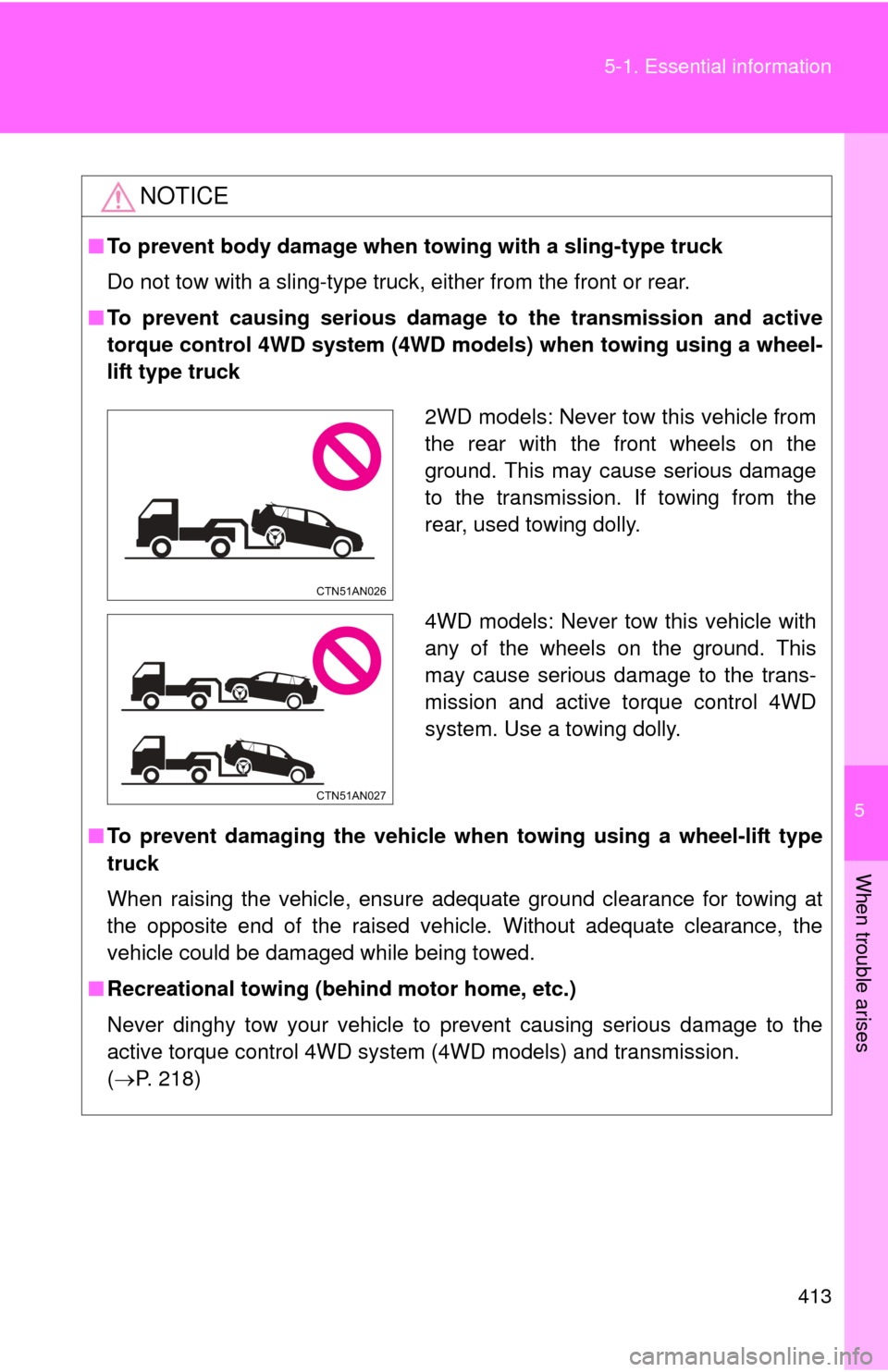Page 408 of 513
5
When trouble arises
407
5-1. Essential information
If your vehicle needs to be towed
Before towingThe following may indicate a problem with your transmission. Contact
your Toyota dealer before towing.
● The engine is running, but the vehicle will not move.
● The vehicle makes an abnormal sound.
If towing is necessary, we recommend having your vehicle towed by
your Toyota dealer or a commercial towing service, using a wheel-lift
type truck or a flat bed truck.
Use a safety chain system for all to wing, and abide by all state/pro-
vincial and local laws.
2WD models: If towing your vehicle with a wheel-lift type truck from
the front, the vehicle's rear wheels and axles must be in good condi-
tions. ( P. 410, 413)
If they are damaged, use a towing dolly or flat bed truck.
4WD models: If towing your vehicle with a wheel-lift type truck, use a
towing dolly. ( P. 410, 413)
Page 409 of 513
408 5-1. Essential information
Emergency towingIf a tow truck is not available, in an emergency your vehicle may be
temporarily towed using a cable or chain secured to the emergency
towing eyelet. This should only be attempted on hard surfaced roads
for short distances at low speeds.
A driver must be in the vehicle to steer and operate the brakes. The
vehicle’s wheels, drive train, axles, steering and brakes must be in
good condition.
Towing eyelet
Page 410 of 513
5
When trouble arises
409
5-1. Essential information
Installing towing eyelet
Remove the eyelet cover using a
flathead screwdriver.
To protect the bodywork, place a
rag between the screwdriver and
the vehicle body, as shown in the
illustration.
Insert the towing eyelet into the
hole and tighten partially by
hand.
Tighten down the towing eyelet
securely using a wheel nut
wrench.
STEP 1
STEP 2
STEP 3
Page 411 of 513
410 5-1. Essential information
Towing with a sling-type truckDo not tow with a sling-type truck
to prevent body damage.
Towing with a wheel-lift type truckFrom the front (2WD models) Release the parking brake.
From the front (4WD models) Use a towing dolly under the rear
wheels.
Page 412 of 513
5
When trouble arises
411
5-1. Essential information
From the rear
Use a towing dolly under the
front wheels.
Using a flat bed truck
If you use chains or cables to tie
down your vehicle, the angles
shaded in black must be 45.
Do not overly tighten the tie
downs or the vehicle may be
damaged.
■ Emergency towin g procedure
Release the parking brake.
Shift the shift lever to N.
Vehicles without smart key system: Turn the engine switch to “ACC”
(engine off) or “ON” (engine running) position.
Vehicles with smart key system: Turn the “ENGINE START STOP”
switch to ACCESSORY (engine off) or IGNITION ON (engine run-
ning) mode.
■ Location of the emer gency towing eyelet
The emergency towing eyelet is in the tool bag. ( P. 430)
STEP 1
STEP 2
STEP 3
Page 413 of 513
412 5-1. Essential information
CAUTION
■Caution while towing
●Use extreme caution when towing the vehicle.
Avoid sudden starts or erratic driving maneuvers which place excessive
stress on the emergency towing eyelet and the cables or chains. Always
use caution for the surroundings and other vehicles while towing.
● If the engine is not running, the power assist for the brakes and steering
will not function, making steering and braking more difficult.
■ Installing towing eyelet to the vehicle
Make sure that towing eyelet is installed securely.
If not securely installed, towing eyelet may come loose during towing. This
may lead to accidents that cause serious injury or even death.
Page 414 of 513

5
When trouble arises
413
5-1. Essential information
NOTICE
■
To prevent body damage when towing with a sling-type truck
Do not tow with a sling-type truck, either from the front or rear.
■ To prevent causing serious damage to the transmission and active
torque control 4WD system (4WD m odels) when towing using a wheel-
lift type truck
■ To prevent damaging the vehicle wh en towing using a wheel-lift type
truck
When raising the vehicle, ensure adequate ground clearance for towing at
the opposite end of the raised vehicle. Without adequate clearance, the
vehicle could be damaged while being towed.
■ Recreational towing (b ehind motor home, etc.)
Never dinghy tow your vehicle to prevent causing serious damage to the
active torque control 4WD system (4WD models) and transmission.
( P. 218)
2WD models: Never tow this vehicle from
the rear with the front wheels on the
ground. This may cause serious damage
to the transmission. If towing from the
rear, used towing dolly.
4WD models: Never tow this vehicle with
any of the wheels on the ground. This
may cause serious damage to the trans-
mission and active torque control 4WD
system. Use a towing dolly.
CTN51AN026
CTN51AN027
Page 442 of 513
5
When trouble arises
441
5-2. Steps to take in an emergency
Stowing the flat tire
Remove any dirt or foreign matter from the disc wheel seat
and the wheel contact surface. Vehicles with aluminum wheels
and a steel wheel for the spare:
Remove the plastic rings from
the wheel nuts of the spare tire
carrier.
Close the back door.
Stow the flat tire on the back door and tighten all wheel nuts
by hand. Using the wheel nut wrench,
tighten the hold-down nuts by
turning them clockwise. Follow
the order shown in the illustra-
tion.
Tightening torque:
66.4 ft•lbf (90 N•m, 9.1 kgf•m)
STEP 1
STEP 2
STEP 3
STEP 4
STEP 5